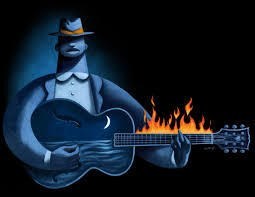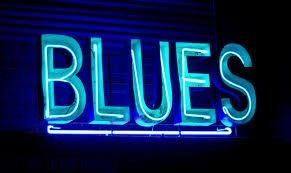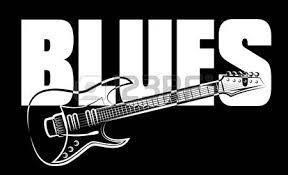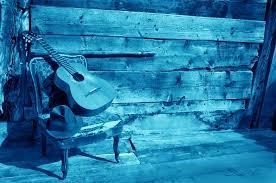VAMOS OUVIR UNS BLUES NA CALOURA?





OS BLUES

“Blues é um género e forma musical originado por afro-americanos no extremo sul dos Estados Unidos em torno do fim do século XIX. O género se desenvolveu a partir de raízes das tradições musicais africanas, canções de trabalho afro-americanas, spirituals e música tradicional. O blues incorporou spirituals, canções de trabalho, canto de campo, ring shout, chant e baladas narrativas simples e rimadas. A forma do blues, omnipresente no jazz, no rhythm and blues e no rock and roll, é caracterizada pelo padrão de chamada e resposta, pela escala de blues e por progressões de acordes específicas, das quais o blues de doze compassos é o mais comum. Blue note é uma nota cantada ou tocada com um timbre ligeiramente mais baixo do que o da escala maior, o que faz com que a nota tenha um som distintamente triste e melancólico; a própria palavra “blues”, em inglês, é sinónima de melancolia. Blues shuffles ou linha de baixo reforçam o ritmo de transe e formam um efeito repetitivo conhecido como groove.

Blues como um género também é caracterizado por suas letras, linhas de baixo e instrumentação. Os primeiros versos tradicionais de blues consistiam em uma única linha repetida quatro vezes. Foi apenas nas primeiras décadas do século XX que a estrutura corrente menos comum tornou-se padrão: o padrão AAB, consistindo de uma linha cantada sobre as quatro primeiras, sua repetição nas quatro próximas e, em seguida, uma linha de conclusão mais longa sobre as últimas linhas. Os primeiros blues muitas vezes tomavam a forma de uma narrativa livre, relacionando frequentemente os problemas experimentados na sociedade afro-americana.

Muitos elementos, como o formato de chamada-e-resposta e o uso de blue notes, podem ser relacionados à música da África. As origens do blues também estão intimamente relacionadas com a música religiosa da comunidade afro-americana, os spirituals. A primeira aparição do blues é muitas vezes datada após o fim da escravidão e, mais tarde, o desenvolvimento do juke joint. Está associada à liberdade recém-adquirida dos antigos escravos. Os cronistas começaram a relatar sobre a música blues no alvorecer do século XX. Blues desde então evoluiu de música vocal não acompanhada e tradições orais de escravos em uma grande variedade de estilos e subgéneros. Os subgéneros de blues incluem country blues, Delta blues e Piedmont blues, bem como estilos de blues urbanos como Chicago blues e West Coast blues. A Segunda Guerra Mundial marcou a transição do blues acústico para o eléctrico e a abertura progressiva da música blues para um público mais amplo, especialmente ouvintes brancos. Nos anos 1960 e 1970, uma forma híbrida chamada blues rock evoluiu”.
OS BLUES NOS AÇORES
Nos Açores realizam-se, desde há vários anos diversos eventos, de renome mundial, ligados a este género musical – os BLUES. Desde 2004, tem lugar na ilha de Santa Maria (no lugar dos Anjos), o “Santa Maria Blues”, que já vai na sua 16ª edição. Este evento é promovido pela associação “Escravos da Cadeinha”. Desde 2018, promovido pela Câmara Municipal de Lagoa, também se realiza, agora em S. Miguel, na Baixa da Areia – Caloura, o “Caloura Blues”, que já vai na sua 2ª edição.
Registe-se, ainda, a realização, no Coliseu Micaelense na cidade de Ponta Delgada, em S. Miguel, em abril de 2019, o “European Blues Challenge 2019 – Açores” – ou seja: “9th European Blues Challenge”, também organizado pela associação “Escravos da Cadeinha”.
A MULTI-CACHE

O GZ desta multi-cache encontra-se dentro de uma propriedade.
A entrada é pública (no horário indicado abaixo).
O Geocaching, neste local, encontra-se expressamente autorizado pela entidade responsável!.
Deverá dirigir-se ao ponto de partida (WP1) e aí… descobrir as coordenadas e a dica para o GZ…
O container final está claramente identificado com o símbolo do Geocaching.
Horário
De 2ª a 6ª feira:
Das 09H00 às 12H00
e das 13H00 às 17H00

LET'S HEAR BLUES AT CALOURA?




THE BLUES

"Blues" is a genre and musical form originated by African Americans in the southern United States around the end of the 19th century. The genre developed from the roots of African musical traditions, Afro-American work songs, spirituals and traditional music. The blues incorporated spirituals, work songs, field singing, ring shout, chant and simple and rhyming narrative ballads. The form of the blues, ubiquitous in jazz, rhythm and blues, and rock and roll, is characterized by the call and response pattern, the blues scale, and specific chord progressions, of which twelve-bar blues are the most common . Blue note is a note sung or played with a tone slightly lower than that of the larger scale, which makes the note have a distinctly sad and melancholic sound; the very word "blues" is synonymous with melancholy. Blues shuffles or bass line reinforce the trance rhythm and form a repetitive effect known as groove.

Blues as a genre is also characterized by its lyrics, bass lines and instrumentation. The first traditional blues verses consisted of a single line repeated four times. It was only in the first decades of the twentieth century that the less common current structure became standard: the AAB standard, consisting of a line sung over the first four, its repetition in the next four, and then a longer completion line over the last few lines. The first blues often took the form of a free narrative, often relating the problems experienced in African-American society.

Many elements, such as the call-and-answer format and the use of blue notes, can be related to African music. The origins of the blues are also closely related to the religious music of the African American community, the spirituals. The first appearance of the blues is often dated after the end of slavery and later the development of the juke joint. It is associated with the newly acquired freedom of the former slaves. The chroniclers began to report on blues music at the dawn of the twentieth century. Blues has since evolved from unaccompanied vocal music and oral traditions of slaves into a wide variety of styles and subgenres. The blues subgenres include country blues, Delta blues and Piedmont blues, as well as urban blues styles like Chicago blues and West Coast blues. World War II marked the transition from acoustic blues to electric and the progressive opening of blues music to a wider audience, especially white listeners. In the 1960s and 1970s, a hybrid form called blues rock evolved. "

THE BLUES IN THE AZORES
In the Azores, several renowned events have been held for several years, linked to this musical genre - the BLUES. Since 2004, the “Santa Maria Blues” has been held on Santa Maria Island (in place of the Angels), which is already in its 16th edition. This event is promoted by the association “Escravos da Cadeinha”. Since 2018, promoted by the Lagoa City Council, the “Caloura Blues”, which is already in its 2nd edition, is also being held, now in S. Miguel, in Baixa da Areia - Caloura.
At the “Coliseu Micaelense” in Ponta Delgada, S. Miguel, in April 2019, the European Blues Challenge 2019 - Azores - the 9th European Blues Challenge - also organized. by the association “Escravos da Cadeinha”.
THE MULTI-CACHE
The GZ of this multi-cache is within a property.
Entry is public (at the time shown below).
Geocaching is here expressly authorized by the responsible entity!
You should go to the starting point (WP1) and there… find out the coordinates and the tip for GZ…
The final container is clearly marked with the Geocaching symbol.
Schedule
From Monday to Friday:
9 a.m. to noon
and from 1:00 p.m. to 5 p.m.
